At the time of publishing this piece, Michel Der Zakarian’s Montpellier sit in eighth place on the Ligue 1 table – the same position in which they finished the prematurely concluded 2019/20 Ligue 1 campaign – having just endured a narrow 3-2 defeat at the hands of league leaders Lille. However, they sit level on points with sixth-placed Monaco and just four points off fourth-placed Rennes, who occupy the UEFA Europa League group stage qualification spot, and eight points off PSG in the third UEFA Champions League qualification spot in France’s top-flight.
Der Zakarian, who finished his playing career at Montpellier in 1997, has been leading La Paillade since May 2017 and is currently under contract with the Occitanie club until the end of June. The season before he took charge of Montpellier, the club finished in 15th place on the league table but they’ve improved under the Armenian, finishing in the top 10 in each of his three full seasons so far.
This consistency has been achieved with the Ligue 1 side playing in a very distinctive way, at least when compared to how the rest of France’s top-flight typically play, and in this tactical analysis piece, we’re going to examine Montpellier’s tactics, as well as try to determine how and why they’re so unique. This tactical analysis piece will explore Der Zakarian’s tactical philosophy, using his Montpellier side to underline some of the key aspects of his footballing vision.
Montpellier’s build-up play
To kick off this tactical analysis of Der Zakarian’s Montpellier, we’re going to look at how La Paillade build up their attacks. To give you a very basic idea of how Montpellier play under Der Zakarian, they’ve kept an average of 44.3% possession this term – the third-lowest possession percentage that any Ligue 1 side has accumulated at this stage of the 2020/21 campaign.
So, evidently, they’re not a heavily possession-based side, as we will explore at greater length later on in this tactical analysis piece. However, they do quite often like to play the ball out short from the back in order to build their attacks through their centre-backs/full-backs/wing-backs.
They typically play this way from goal-kicks or when building up other attacks where the opposition are settled in an organised defensive block, not leaving much space in behind. During these situations, Der Zakarian likes his deep-lying players – typically the centre-backs, full-backs/wing-backs and at least one central midfielder – to try and attract pressure from the opposition, with the aim of creating more space in behind their last line of defence for Montpellier to exploit.
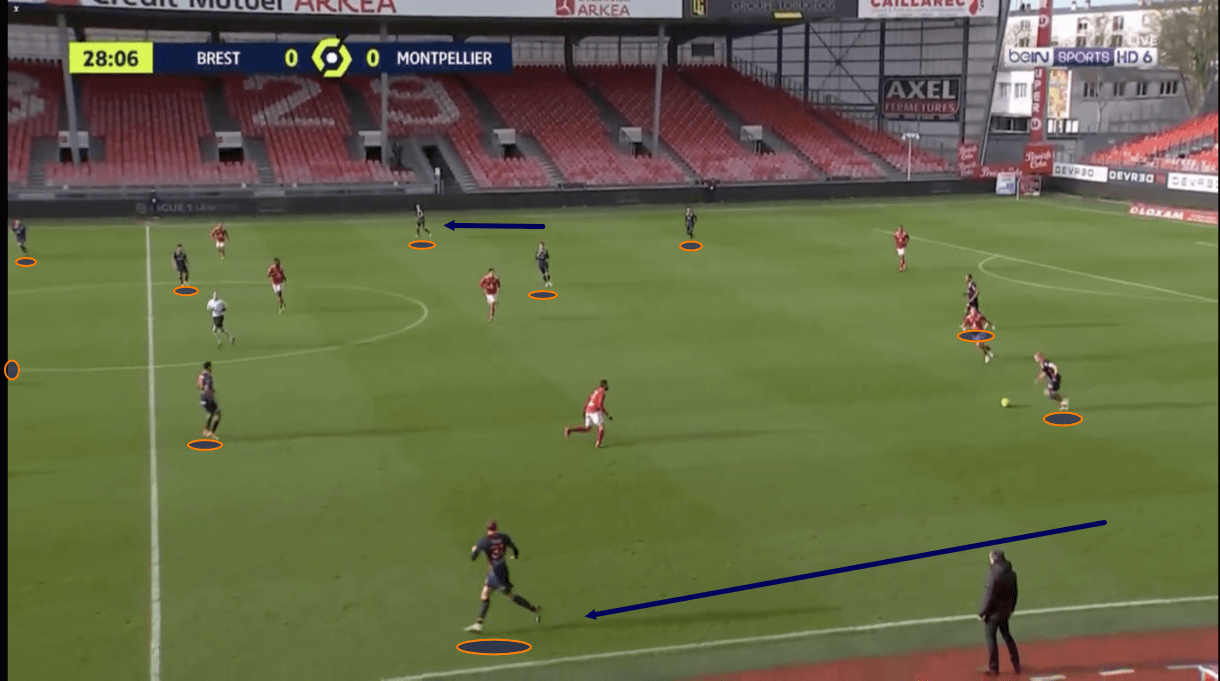
Der Zakarian typically sets his side up in either a 3-4-1-2 or a 4-3-3 formation. However, the way in which they build-up doesn’t really change, either in terms of the general aim of their build-up or the shape they settle into when building up their attacks. In the image above, we can see them playing out from the back while playing in a 3-4-1-2 shape. Their wing-backs spread out very wide and begin to push high into the midfield line, while their centre-backs also spread out quite wide.
The wing-back nearest to the centre-back on the ball pushes slightly higher than the wing-back on the opposite side, while the centre-back on the ball also carries the ball out wide, forming something similar to a back-four and that’s why the shape they use when building up with three centre-backs doesn’t differ greatly from the shape they use when building up with four centre-backs. There’s generally a cross-formation consistency with regards to their build-up, with their players knowing their respective roles.
Meanwhile, with regard to the midfield, as would be the case in their 4-3-3, one central midfielder in the 3-4-1-2 drops deep, with the other pushing higher and joining the ‘10’.
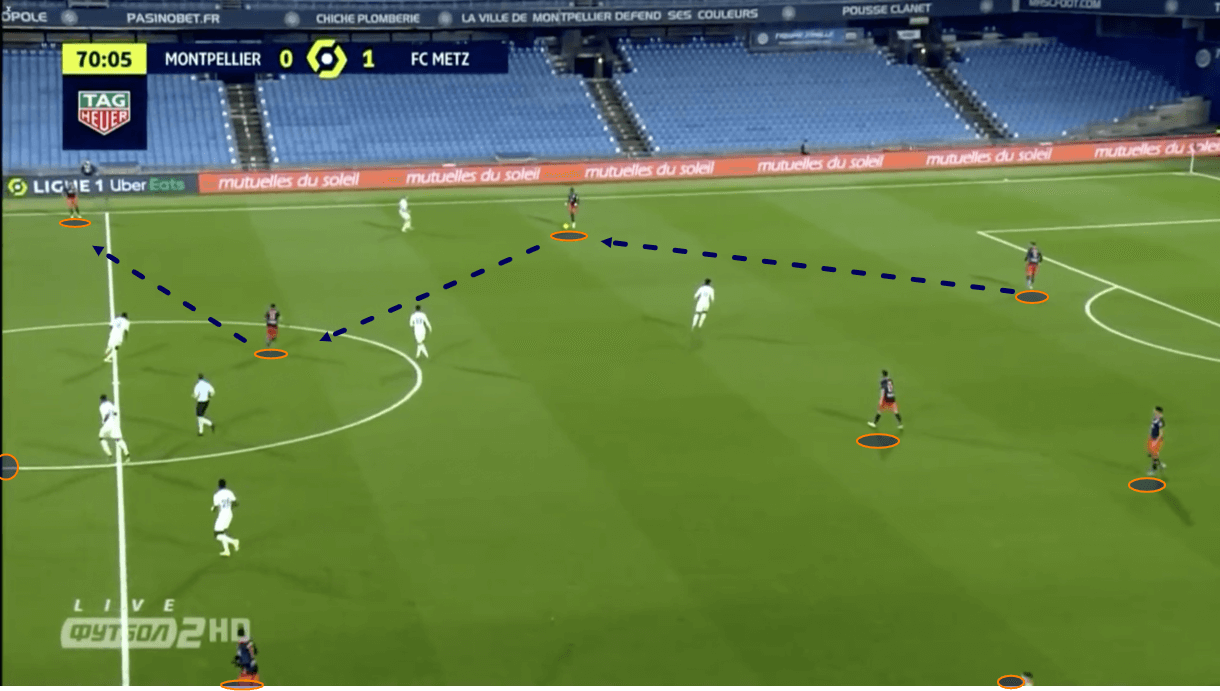
This next image gives us a glance at Der Zakarian’s side building out while playing in a 4-3-3 and we can see that the shape is quite similar, with the full-backs and centre-backs both spreading out very wide.
Additionally, something else that can be seen in both of these images is that Der Zakarian likes his side to build-up via the wings. They will build through the holding midfielder at times if free but typically, they like to focus their build-up in the wide areas. With how spread out their shape gets during the build-up, perhaps the holding midfielder would become somewhat isolated and so it might make more sense to focus their build-up out wide, with the more advanced central midfielders pushing out to combine with their teammates as can be seen above.
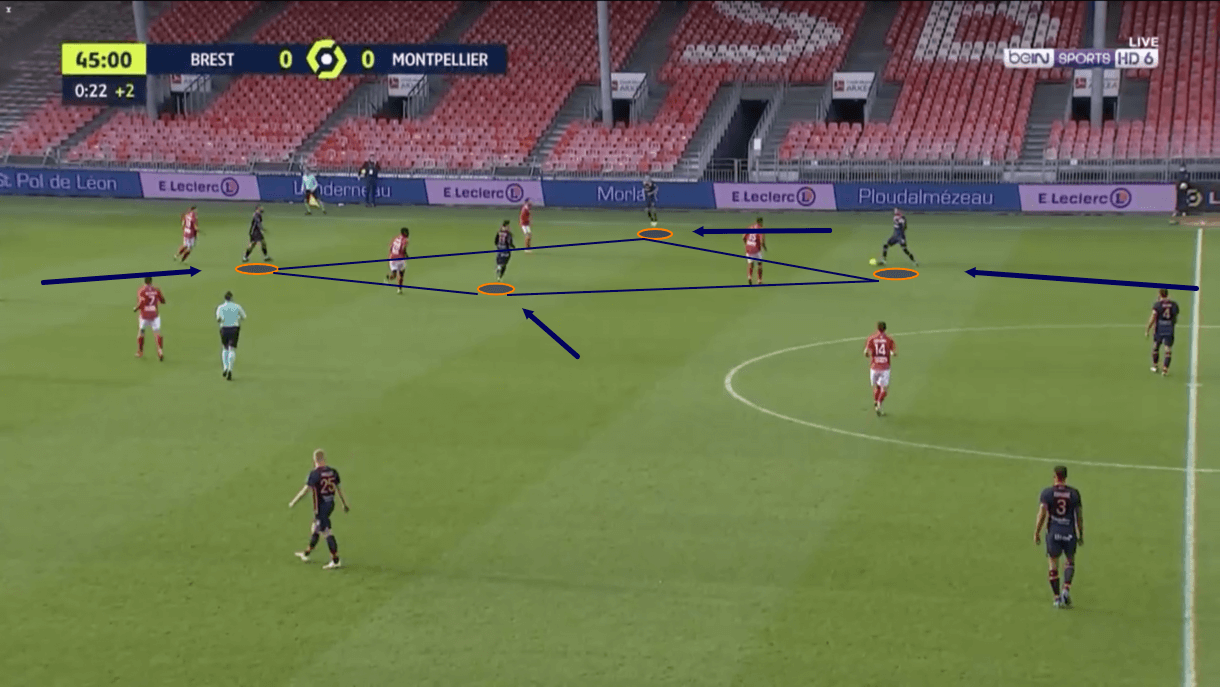
This next image shows us an example of a more advanced stage of an attack where Montpellier are building up via the wing. In this particular example, they’re playing with a back three but they use the same concept when playing with a back four.
The centre-back on the ball carries the ball out from the back, the wing-back pushes high out wide, the near central midfielder shifts over and the centre-forward drops into the half-space, forming a diamond shape on the wing for their side. This is a common shape to see Montpellier playing in and is one intelligent way that they try to gain a superiority over their opponent out wide to create chances.
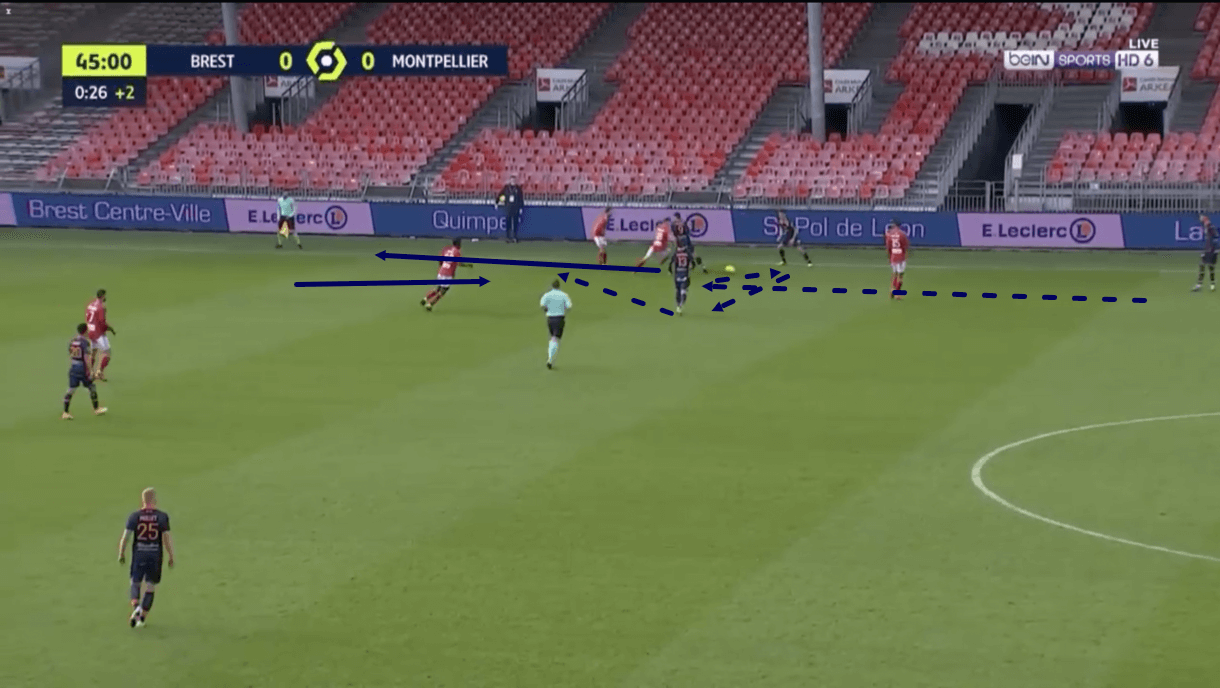
As they do so, the centre-back finds the centre-forward on the other end of the diamond, who combines with the wing-back before setting off on his run in behind. As he does so, the wing-back plays the ball into the central midfielder and he can then find the centre-forward moving in behind the defensive line with a diagonal through ball.
This bit of play happens very quick, with Montpellier’s players taking very few touches after the ball is played from the centre-back to the centre-forward. This shows us another common theme of Der Zakarian’s side, which is that they like to play quick, one/two-touch football once they progress the ball into these areas, in order to distort the opposition’s shape and take full advantage of their diamond. While Der Zakarian likes his side to play slow in the initial stages of the build-up to attract pressure, once in the opposition half, Montpellier don’t usually spend very long at all on the ball, generally aiming to break through the defensive line quickly.
When they’ve just regained possession with the opposition having committed numerous players high up the pitch and there’s already plenty of space present in behind for Montpellier to exploit, they don’t build-up patiently. Instead, they get the ball out wide quickly, with the aiming of hitting the opposition on the counter and exploiting that space.
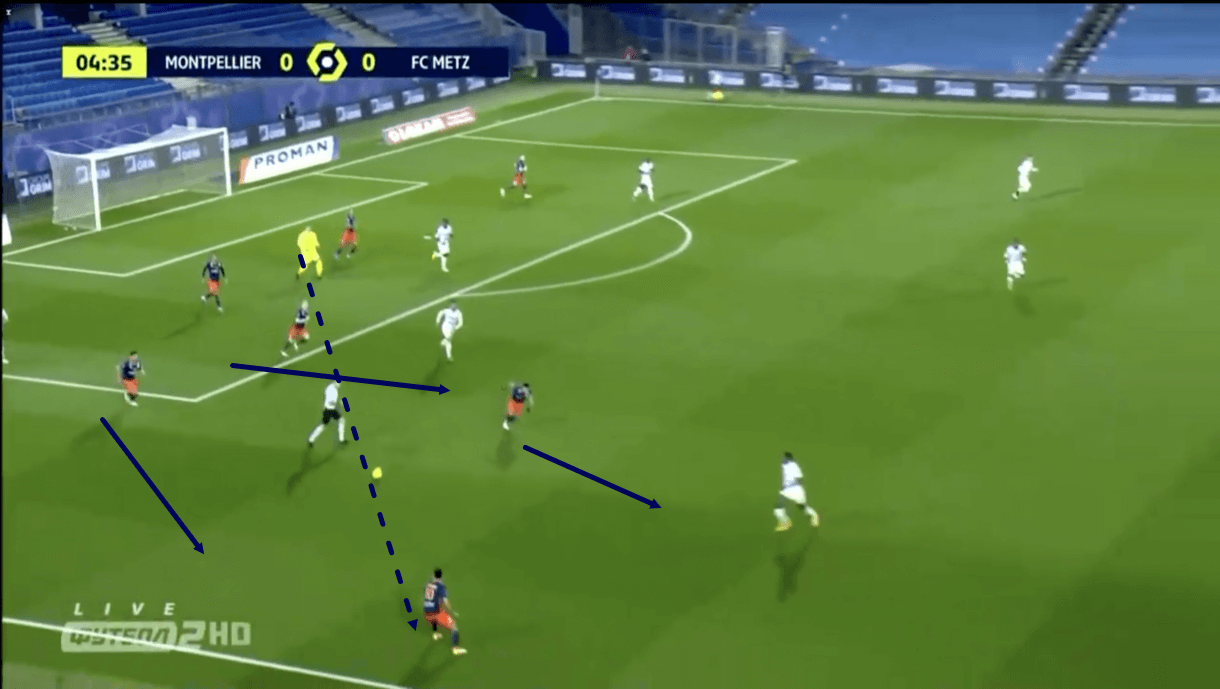
Der Zakarian very much sets his side up with the sole aim of firstly, creating space in behind the opposition’s last line and secondly, using their quick combination play and pace to exploit that space from the wide areas. If that space is already present when starting their attack, they’re happy to skip straight to step two. The players have a clear aim and idea in mind of what the manager wants, though, which is for them to get in behind the last line from out wide.
In this particular example above, the opposition clearly have a lot of men committed in Montpellier’s half and so, the goalkeeper collects the ball and throws it straight out to the runner on the wing. Though the ball is played behind him, slowing him up somewhat, the aim is clear.
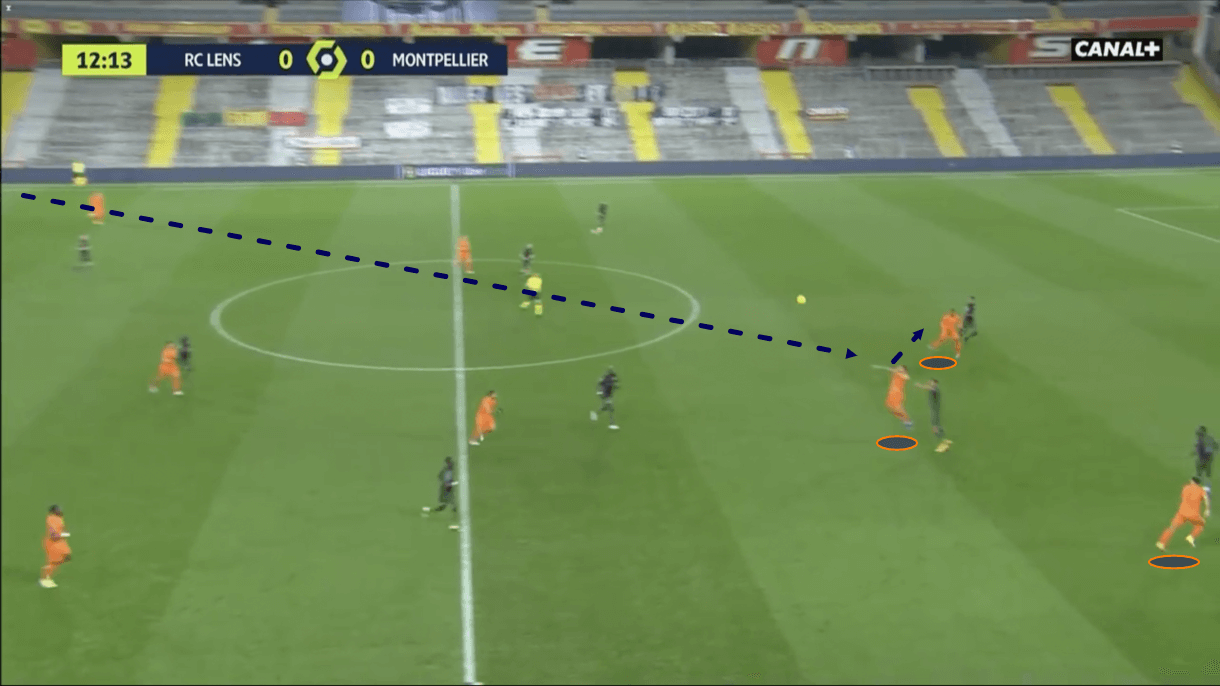
Der Zakarian is also more than happy for his side to go long from the goalkeeper if space is there in behind the last line for them to exploit. It is rarer for them to play this way as a default during games but they have done it, notably, as seen in the image above, in their recent 3-2 win over Lens.
In this game, Lens played with a back three and Der Zakarian matched three attackers up with them in a 4-3-3, exploited the aerial ability of Andy Delort and aimed to get his other two forwards in behind from his flick-ons. So, while it often is, it’s not always about the wings or the patient build-up for Der Zakarian, but he always has a plan in place to get his attackers in behind a relatively high defensive line.
Montpellier in the final third
Next up, we’ll take a look at how Der Zakarian’s Montpellier play within the final third. With Montpellier breaking through the last line of defence via the wings more often than not, this leads us into the next distinctive characteristic of La Paillade’s tactics – their heavy focus on crossing.
At present, Montpellier have played the fourth-highest number of crosses of any Ligue 1 side this term. In contrast, they’ve played by far the lowest number of through balls of any team in France’s top-flight and perhaps that also highlights how much they focus on breaking through the opposition backline via the wings and creating chances via crosses once they reach the final third.
Once played in behind after combining with teammates out wide, as previously analysed, Montpellier’s wide men generally take the ball forward and play a cross. It’s fairly uncommon for Der Zakarian’s men to try and beat opposition players on their own, and usually, they will look to run into space to free themselves up and get onto the end of a pass before going on to get into a crossing position.
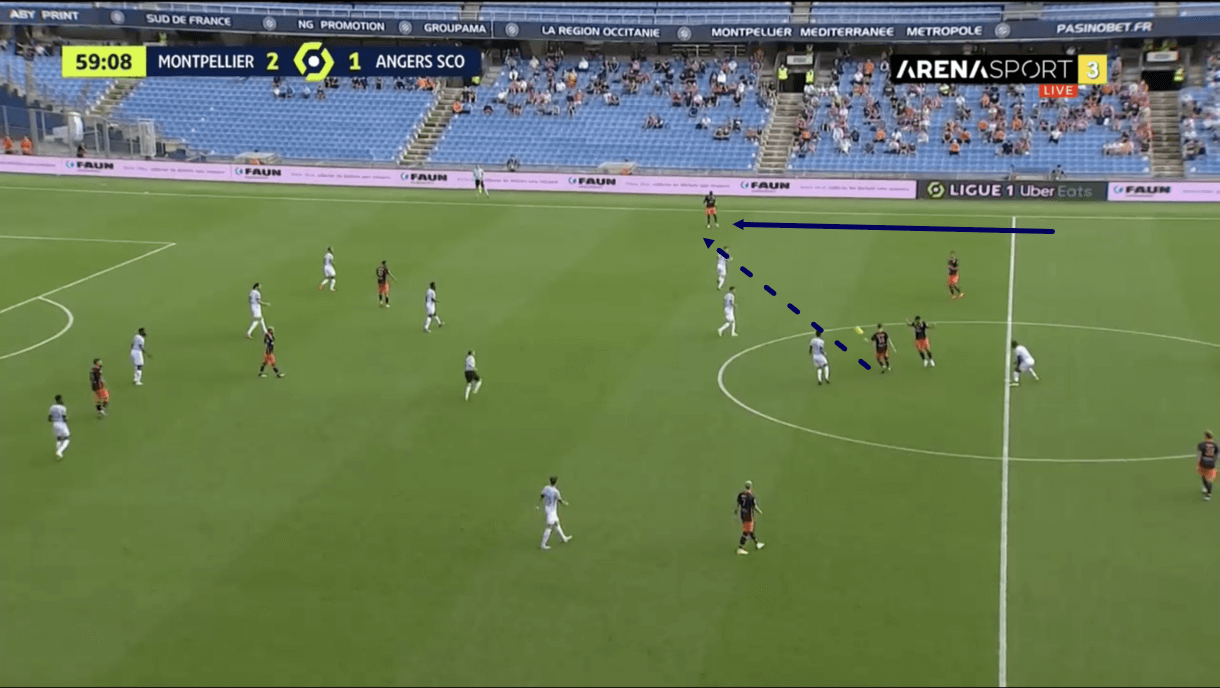
Another way Montpellier get into favourable crossing positions out wide is by exploiting the width via their full-backs/wing-backs when playing against a compact opposition block. Right-back Junior Sambia, in particular, has been very active in probing forward into space when an opposing team’s compact block allows him to, and getting himself into a position to send the ball into the box. Usually, when playing with a back four, only one of Der Zakarian’s full-backs, if either, will go forward at a given time.
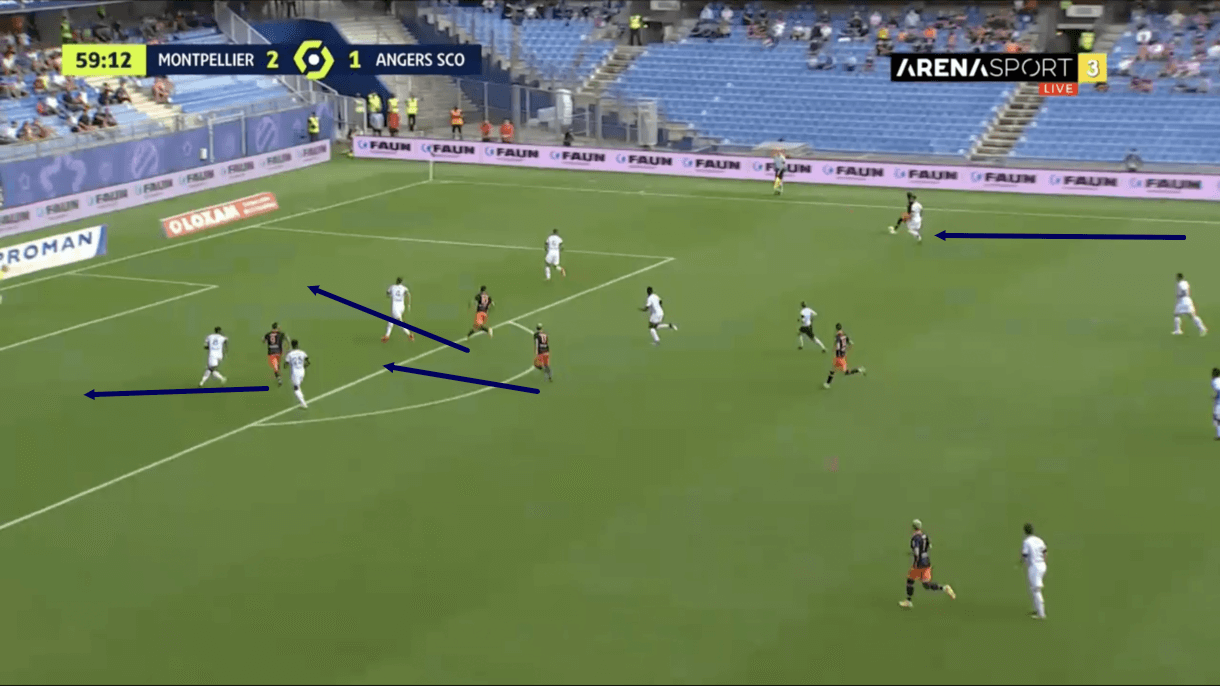
After receiving the pass out wide in the previous image, Sambia carries the ball forward, but not extremely far up the pitch. The right-back doesn’t like to get all the way to the byline before sending the ball into the box – this area we see him occupying in the image above, or an even deeper area still, is where he typically likes to play his crosses from. With four league assists to his name at this stage of the 2020/21 campaign, Sambia is currently Montpellier’s third-highest Ligue 1 assist provider, highlighting just how effective a playmaker he can be in these areas.
Meanwhile, Montpellier’s attackers also generally like to get onto the end of Sambia’s relatively deep crosses and their intelligent movement inside of the penalty area combines with his exquisite delivery to create Montpellier’s significant goal threat from headers inside the box, via these types of crosses.
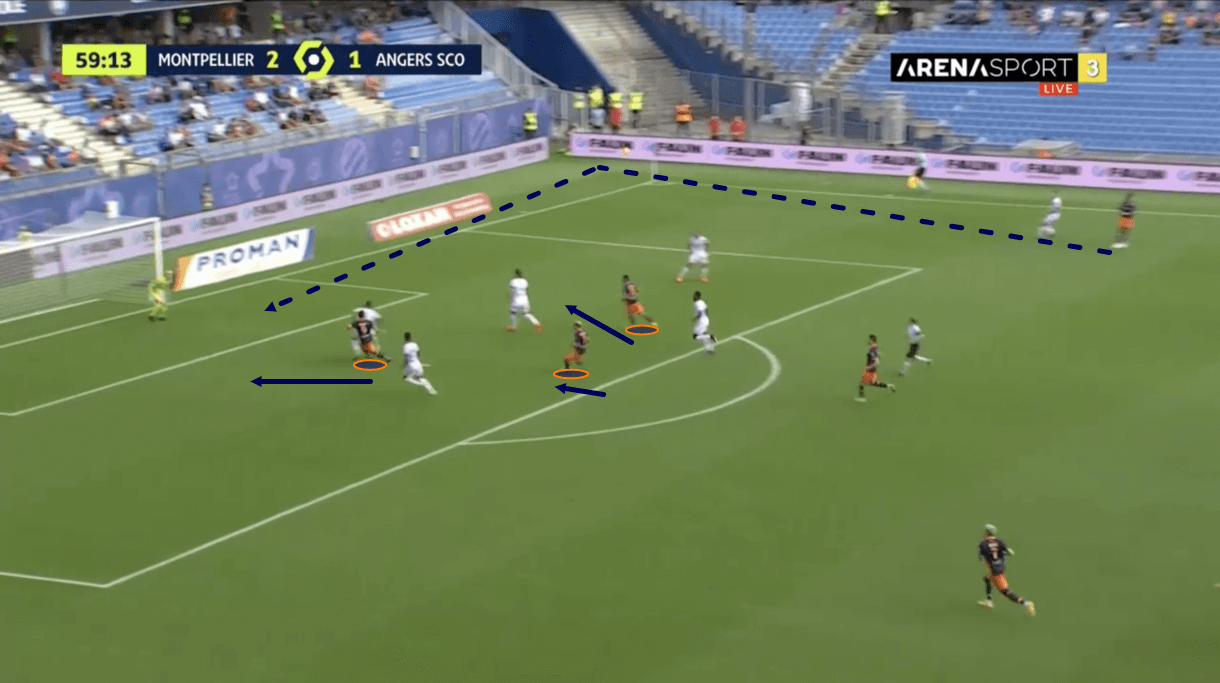
As this cross is played into the box from Sambia, Montpellier’s players’ runs show us another common feature of the club’s offensive game. They always have one centre-forward making his run across the front of the goal towards the front post and the other simultaneously directing their run towards the back post. In this particular image, we can see that the ‘10’ has also got into the box and is sitting slightly deeper, occupying a good position to get onto the end of a potential knockdown from the cross.
However, Der Zakarian’s side doesn’t always have three men inside of the box, though they do have two men in their most of the time, making these specific runs. Additionally, their crosses are usually directed towards the man at the back post but the man running towards the front post does still play an important role, in that they attract at least one defender away from the man at the back post and create space centrally if the ‘10’ does run in slightly later, as is the case here.
These tactics have helped Montpellier to become one of Ligue 1’s most dominant sides in the air.
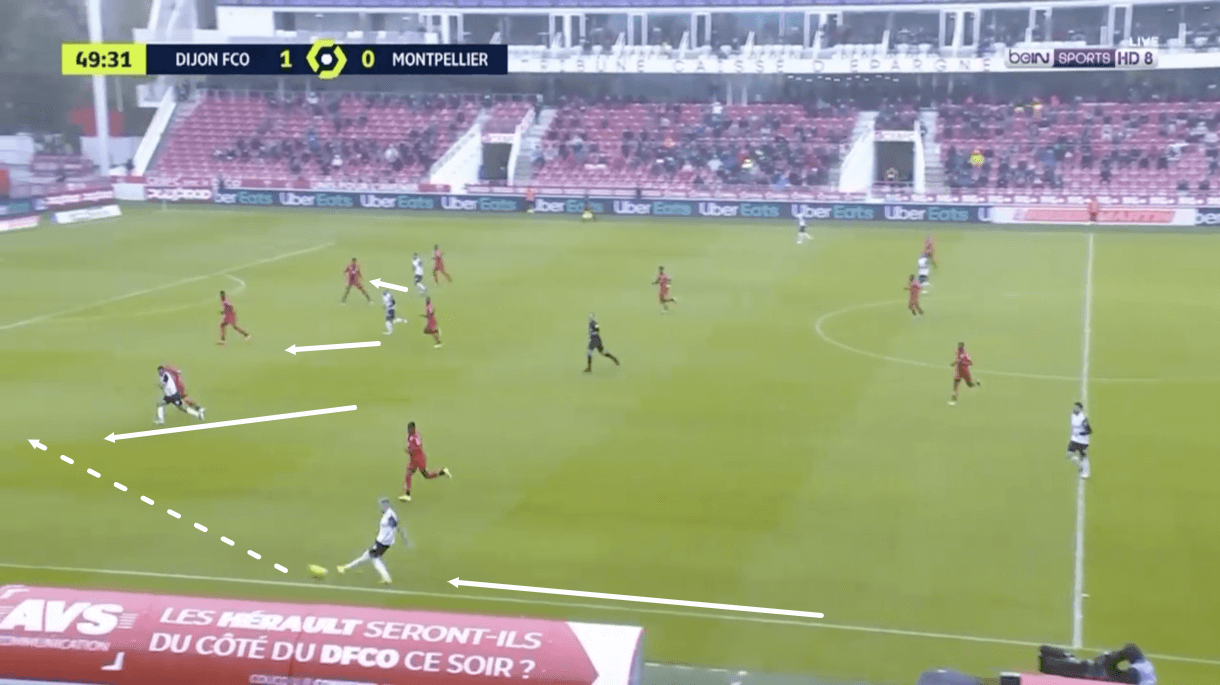
Montpellier’s full-backs/wing-backs aren’t the only ones who bring a crossing threat to the table for Der Zakarian’s side, however, and all of their crosses don’t come from this deep position that Sambia likes to cross from. Montpellier also possesses a crossing threat from further up the pitch, as their centre-forwards make runs out wide, as can be seen in this image above, to get into more advanced crossing areas closer to the byline.
As they do this in their 3-4-1-2 shape, the ‘10’ pushes up into the vacated centre-forward position before making the near-post run that is a feature of their game inside the final third, while the far-side centre-forward makes his run towards the back post.
This presents a somewhat unique threat to the opposition and it asks different questions of their backline to the ones being presented to them when the crossing threat is deeper. The intelligent movement and tactical knowledge relating to Der Zakarian’s system, of Montpellier’s attackers is key to making this work and it’s highlighted in this passage of play.
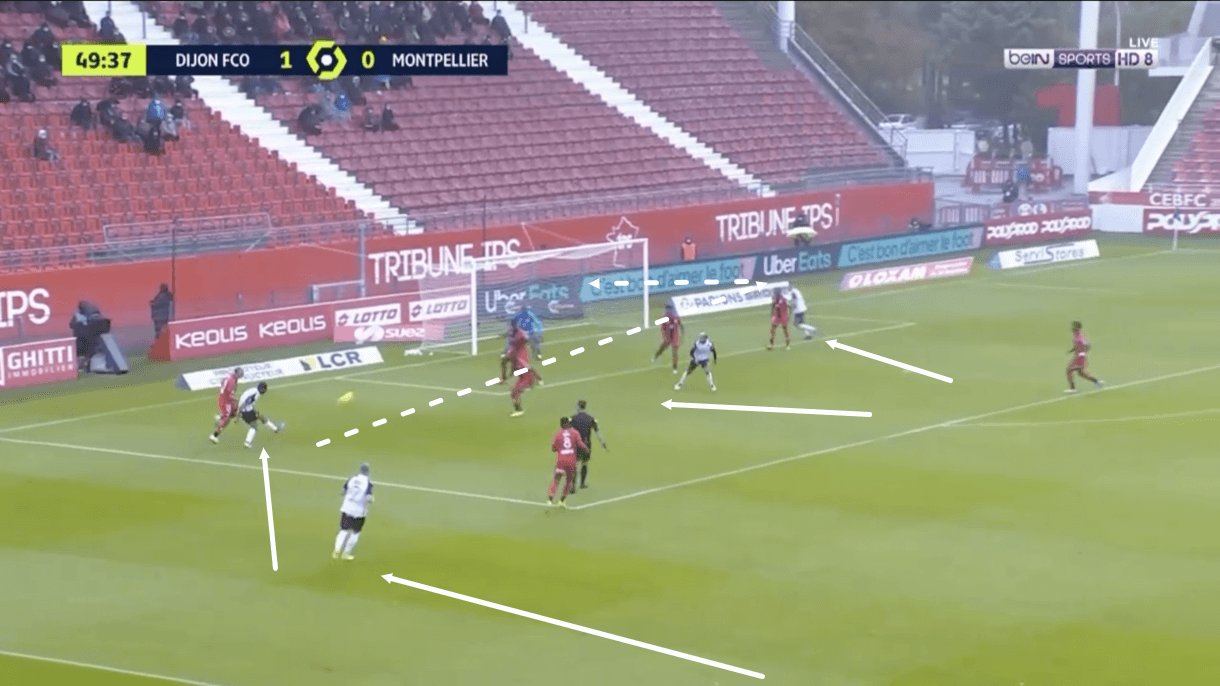
As this move plays out, we see the positions that Montpellier’s newly-formed front two ends up in as a result of their movement, as well as the more advanced that the crosser has moved into before playing the ball across goal.
The wing-back who initially played the ball through to the centre-forward also continued his run to offer support to the attacker, though he didn’t need it as he dribbled all the way to this area just inside of the penalty box before finding his natural striking partner at the back post.
So, while this is a different threat Montpellier possess, it is still centred around crossing, which is clearly the main aspect to the offensive game of Der Zakarian’s side within the final third.
Montpellier in defence
Defensively, Der Zakarian sets his side up to be anything but ‘aggressive’. This is, perhaps, exemplified by the fact that La Paillade have got the highest PPDA (23.78) of any Ligue 1 side thus far for the 2020/21 campaign by some distance, which is an indication of their extremely low pressing intensity.
Additionally, their passive defensive style is also evident in the fact that they’ve engaged in the second-lowest number of defensive duels of any team in France’s top-flight at this stage of the 2020/21 Ligue 1 season.
They have also made the sixth-highest number of blocks of any team in France’s top-flight, which is another result of Der Zakarian’s passive defensive tactics, with the Armenian setting his side up to drop deep, protect the goal, at times allowing opposition players to progress into shooting territory before then getting bodies in front of the shot.
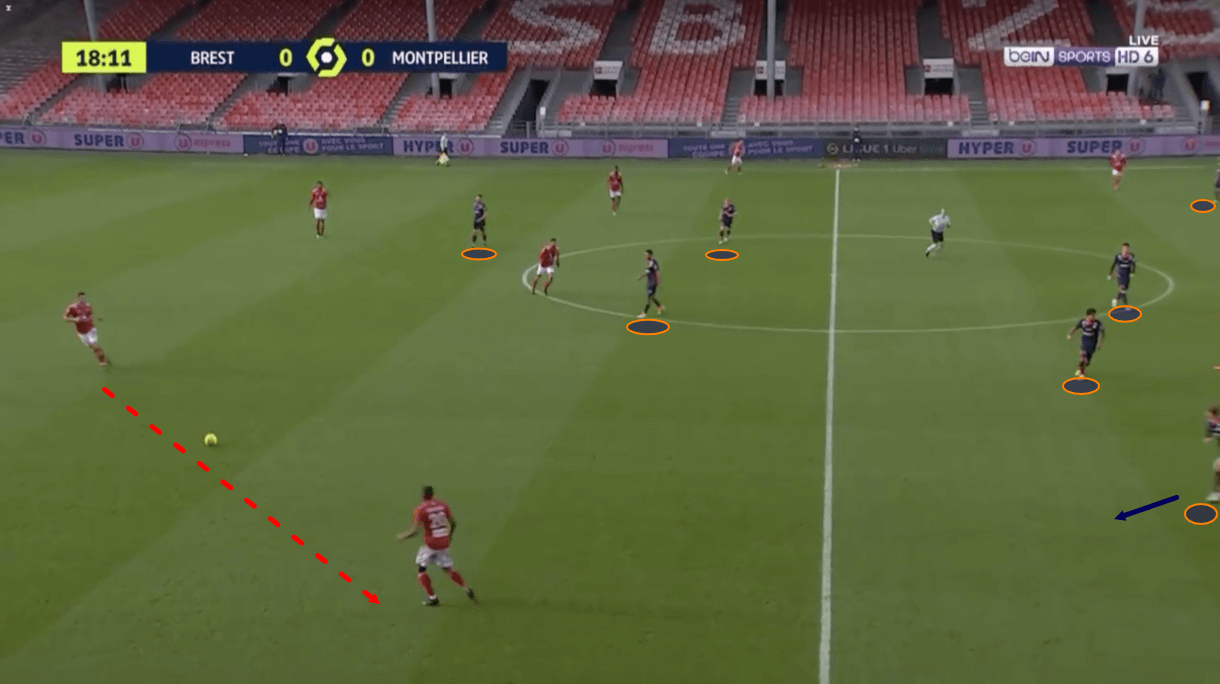
The image above shows us an example of Montpellier set up in their 3-4-1-2 shape versus a Brest side playing out from the back. As we can see, the opposition are just about to progress the ball up to the halfway line at this stage of the build-up and thus far, Montpellier have applied no pressure. Montpellier’s strikers pressed neither the opposition goalkeeper nor centre-backs, and the strikers also don’t begin to apply pressure upon the ball being played out to the full-back here.
Instead, Der Zakarian has his front three essentially cut off passing lanes into the centre of midfield. With the two Montpellier central midfielders not too far behind them, as La Paillade maintain a fairly vertically compact shape when set up to defend against a team building out from the back, this shows us a key aspect to Der Zakarian’s defensive tactics, which is that, first and foremost, he wants to pack the centre of the pitch, cutting off the possibility of the opposition playing through this area, thus forcing them out wide.
As the ball is played from the Brest centre-back out to the full-back here, Montpellier’s near wing-back does begin to press to some extent, as they tend to apply a bit more pressure once the ball approaches the halfway line, however, this often just forces the opposition backwards, with the pass into the centre cut off by the striker and Montpellier’s overall central superiority and the pass back to the centre-back remaining open.
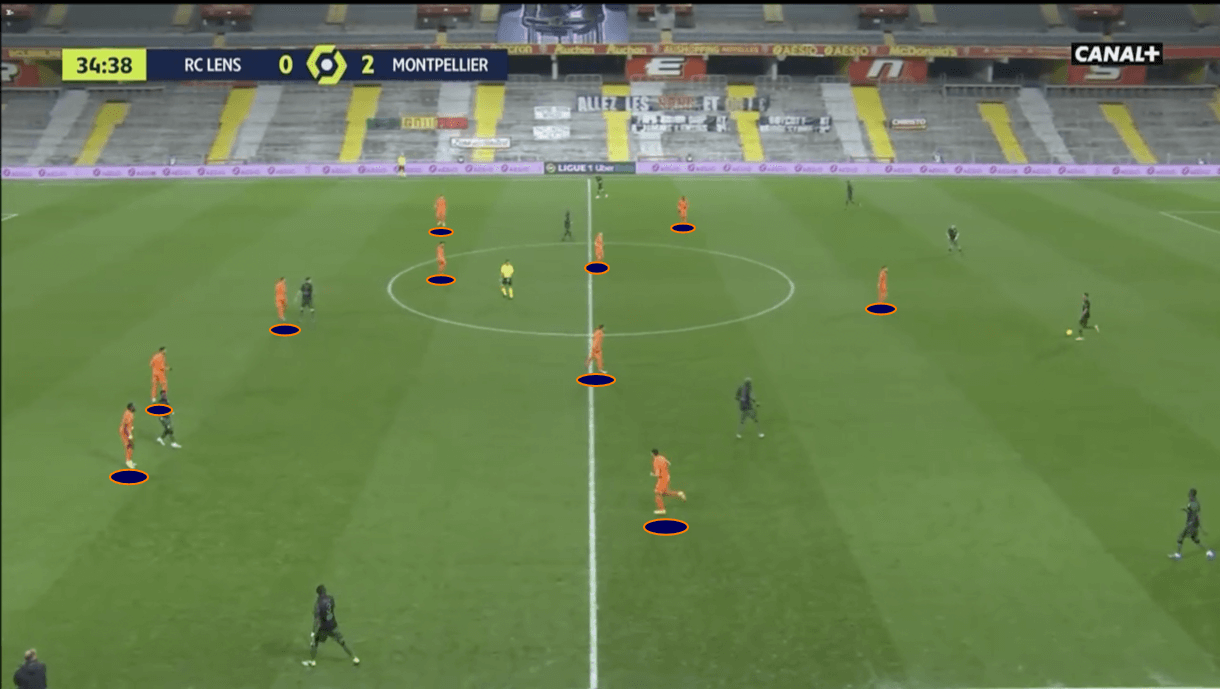
This next image shows us an example of Montpellier’s defensive shape in their second-most popular formation – the 4-3-3 – with the Occitanie side dropping into more of a 4-1-4-1 off the ball and their holding midfielder dropping deep enough to almost appear as though he is another centre-back, though this quality of his is valuable in that it sees him plug gaps that open up in the defensive line as a result of the opposition attackers’ movement.
The primary concepts of Der Zakarian’s defensive tactics remain consistent in the 4-3-3 with what they are in the 3-4-1-2. Montpellier defend passively, not really applying any pressure until the opposition approaches the halfway line and prioritising the protection of the centre of the pitch, while maintaining vertical compactness in their shape.
Montpellier in the transition to defence
The transition to defence is another notable aspect to Montpellier’s tactics under Der Zakarian but it’s more of a negative aspect than perhaps any of the other areas of the Armenian’s tactics with the Ligue 1 side that we’ve discussed thus far.
The Occitanie side struggles in the transition to defence and it may be fair to say that this area of their game is a notable weakness.
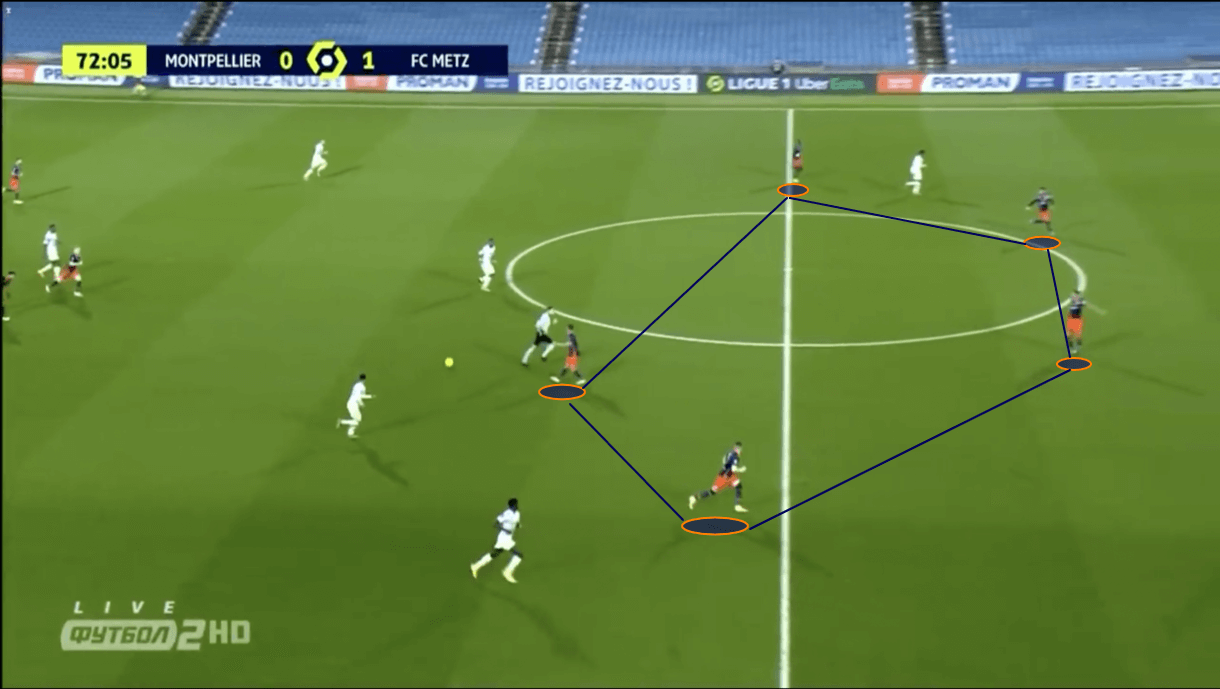
Firstly, in the image above, we can see how Montpellier typically look when defending against an opposition counter-attack. In a 4-3-3, their back four typically stays back, along with the sole holding midfielder, with the front three and the two advanced central midfielders generally advancing further up the pitch into the final third. As we mentioned previously, one of Montpellier’s full-backs does also get forward on occasion, meaning he may not always be in this position in the transition to defence either.
As we can see here, the vertical compactness that is a key feature to Der Zakarian’s defensive setup when Montpellier are settled in their organised defensive shape doesn’t exist as much in the transition to defence between the holding midfielder and the other midfielders and attackers and this is something that opposing teams can exploit.
We established while analysing Montpellier’s build-up that their holding midfielder can become isolated and with that being the case when building attacks, it’s also often the case when transitioning to defence and when being counter-attacked, it’s something that is often exploited as opposing teams take advantage of this isolation by overloading the centre.
This also shows us how another key aspect of Der Zakarian’s defensive tactics in a settled shape – the protection of the centre of the pitch – goes out the window in the transition to defence and is exploited by counter-attacking opponents.
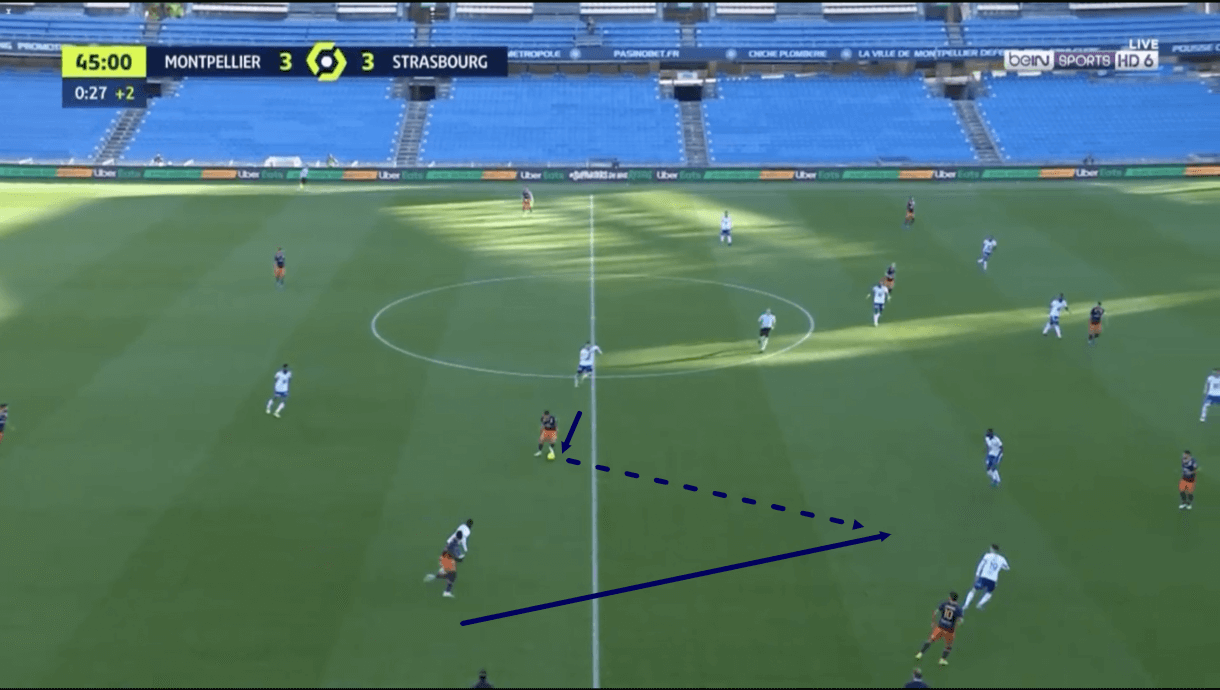
This next image also shows us how Montpellier can leave themselves very vulnerable to counter-attacks through the middle of the park due to Der Zakarian’s offensive tactics. Here, the right-back can be seen beginning to burst forward, performing a one-two with the holding midfielder who’s pushed out wide to an extent to offer the right-back an option.
However, as we can clearly see, this leaves the middle of the pitch in front of the backline basically void of Montpellier shirts and as the holding midfielder’s attempt to complete this one-two is intercepted by a Strasbourg player, they exploit this obvious weakness in the centre of the pitch and counter-attack straight through this area.
So, while Der Zakarian’s offensive tactics in the build-up help them to create via the wings, his side do leave themselves very open on the counter through a dangerous area – the very centre of the pitch.
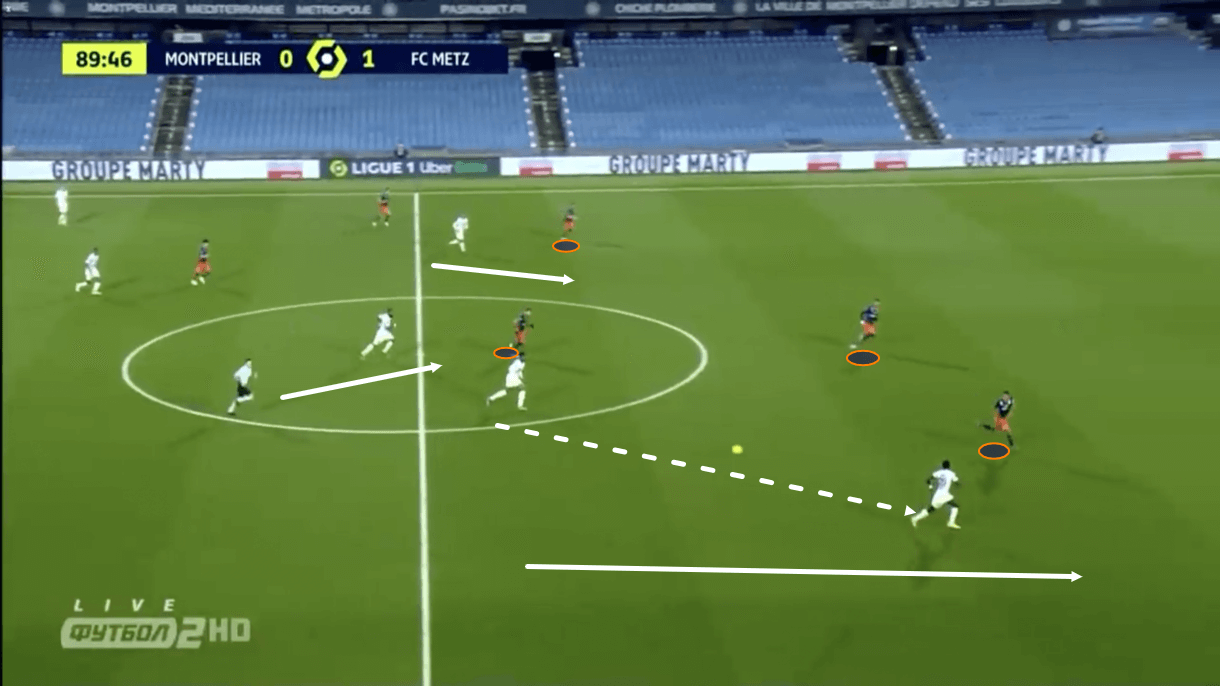
This next passage of play will provide us with another example of how Der Zakarian’s side struggle in the transition to defence. Above, we can see Metz on the counter-attack having just won the ball back in the middle of the park. These examples highlight that it’s not so uncommon for Montpellier to lose the ball in the centre of the pitch, which makes this weakness of there’s all the more dangerous.
As they win the ball back, it’s played out wide to a runner threatening to move in behind the Montpellier defensive line while also stretching the backline via his movement.
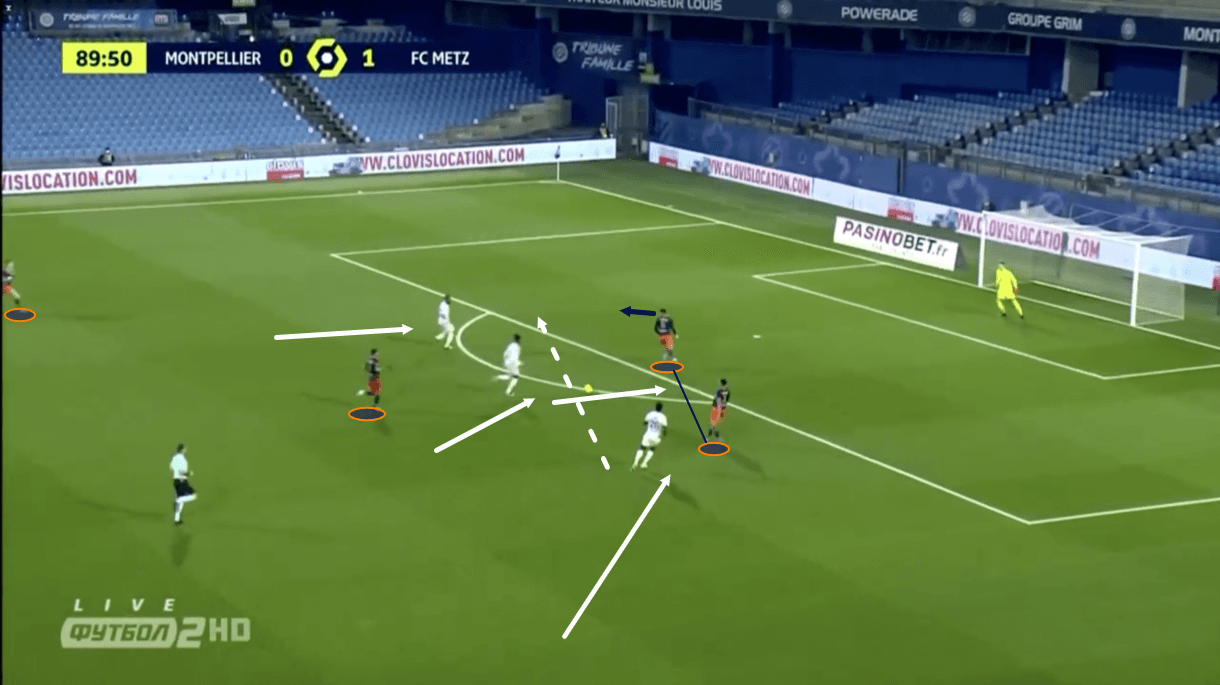
This attacker comes back inside and plays the ball across goal, with his side having created a 3v2 overload just outside the penalty box on the counter-attack. This highlights a lack of significant pace in Montpellier’s backline – another weakness of there’s in the transition to defence.
As this ball is played across goal, it stretches Montpellier’s backline once again, creating a gap in the centre for the numerically dominant Metz to exploit. It’s not uncommon to see opposing sides stretching Montpellier’s backline like this and breaking through as a result.
Conclusion
To conclude this tactical analysis piece, Der Zakarian’s tactics at Montpellier are unique, in that relative to the rest of Ligue 1, his side is extremely passive in defence and rely heavily on crosses within the final third.
They’ve enjoyed some success via their tactics on and off the ball this term, getting themselves into a healthy position at this stage of the campaign and if they can work on their weakness in the transition to defence, they could well push for one of those European qualification spots this term thanks in no small part to Der Zakarian’s unique tactical approach.



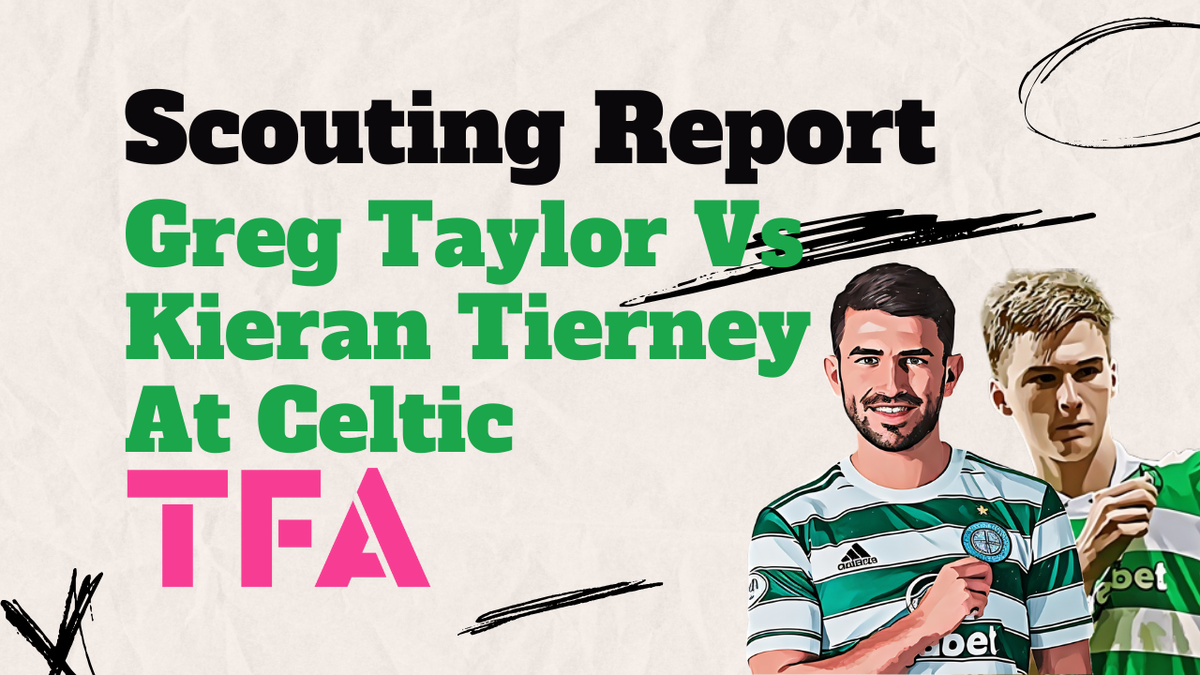
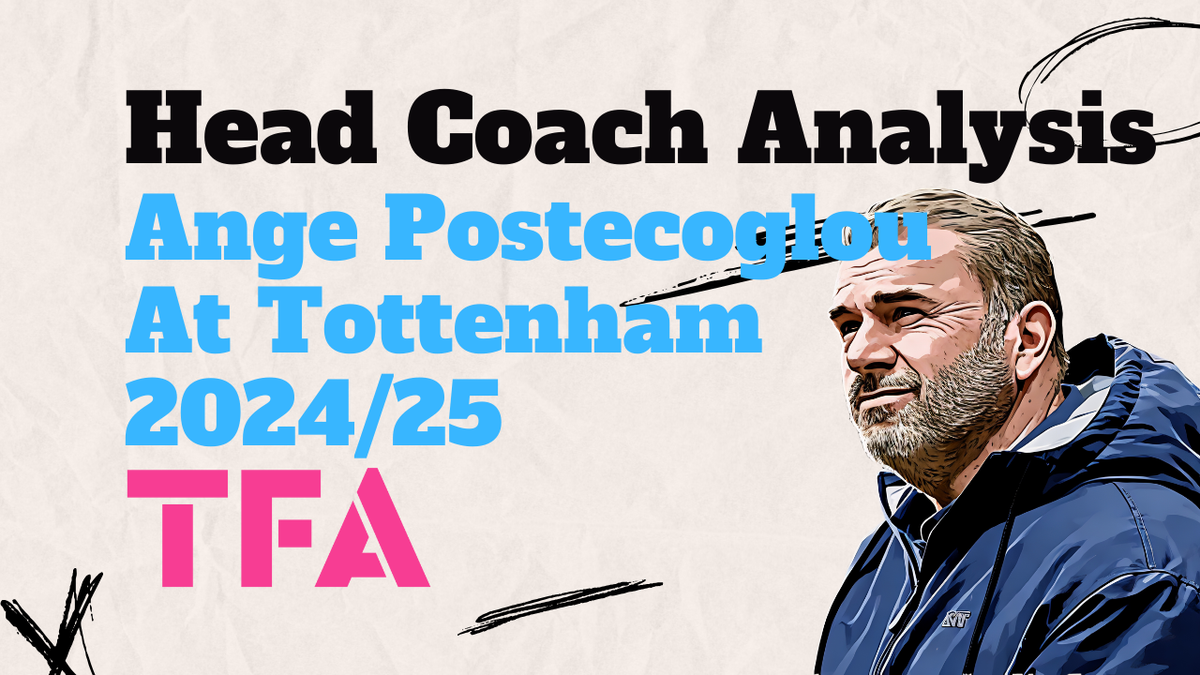
Comments